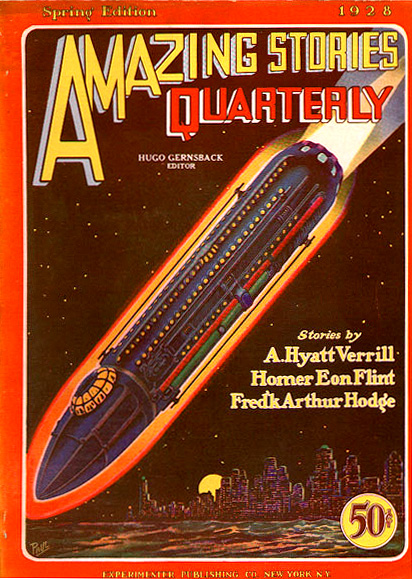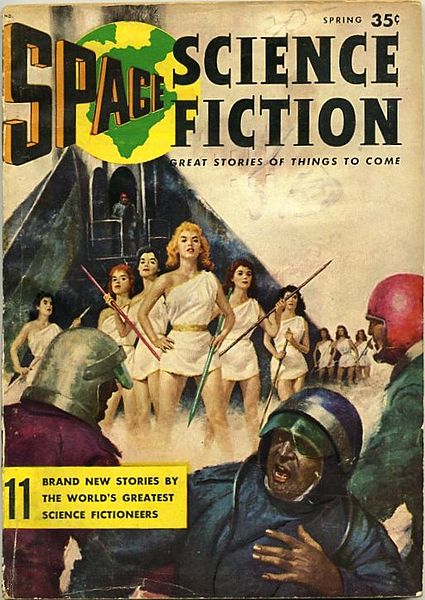Space opera is a subgenre of science fiction that often emphasizes romantic, often melodramatic adventure, set mainly or entirely in outer space, usually involving conflict between opponents possessing advanced abilities, (sci-fi) weapons, and other (sci-fi) technology. The term has no relation to music but is instead a play on the term "soap opera".
Definition

The term "space opera" was coined in 1941 by fan writer (and later author) Wilson Tucker, in a fanzine article, as a pejorative term. At the time, serial radio dramas in the US had become popularly known as soap operas because many were sponsored by soap manufacturers. Tucker defined space opera as the SF equivalent: a "hacky, grinding, stinking, outworn, spaceship yarn". Even earlier, the term horse opera had come into use as a term for western films. In fact, some fans and critics have noted that the plots of space operas have sometimes been taken from horse operas and simply translated into an outer space environment, as famously parodied on the back cover of the first issue of Galaxy Science Fiction. Still, during the late 20s and early 30s when the stories were printed in science fiction magazines, the stories were often referred to as "super-science epics".
Beginning in the 1960s, and widely accepted by the 1970s, the space opera was redefined, following Brian Aldiss' definition in Space Opera (1974) as (in the paraphrase Hartwell and Cramer) "the good old stuff". Yet soon after his redefinition, it began to be challenged, for example, by the editorial practice and marketing of Judy-Lynn del Rey and in the reviews of her husband and colleague Lester del Rey. In particular, they disputed the claims that space operas were obsolete, and Del Rey Books labeled reissues of earlier work of Leigh Brackett as space opera. By the early 1980s, space operasâ€"adventure stories set in spaceâ€"were again redefined, and the label was attached to major popular culture works such as Star Wars. It was only in the early 1990s that the term space opera began to be recognized as a legitimate genre of science fiction. Hartwell and Cramer define space opera as "colorful, dramatic, large-scale science fiction adventure, competently and sometimes beautifully written, usually focused on a sympathetic, heroic central character and plot action, and usually set in the relatively distant future, and in space or on other worlds, characteristically optimistic in tone. It often deals with war, piracy, military virtues, and very large-scale action, large stakes."
History

Early works related to but preceding the subgenre contained many elements of what would become space opera. They are today referred to as proto-space opera. The earliest proto-space opera was written by a few little-known mid-nineteenth century French authors, for example Star ou Psi de Cassiopée: Histoire Merveilleuse de l’un des Mondes de l’Espace (1854) by C. I. Defontenay and Lumen (1872) by Camille Flammarion. Not widely popular, proto-space operas were nevertheless occasionally written during the late Victorian and Edwardian science fiction era. Examples may be found in the works of Percy Greg, Garrett P. Serviss, George Griffith and Robert Cromie. One critic cites Robert William Cole's The Struggle for Empire: A Story of the Year 2236 as the first space opera. The novel does depict an interstellar conflict between solar men of Earth and a fierce humanoid race headquartered on Sirius. However, the idea for the novel arises out of a nationalistic genre of fiction popular from 1880â€"1914, called future war fiction, and many would therefore dispute its claim to be called the first space opera. While these early stories included interplanetary and interstellar travels and adventures, intergalactic travels and galaxies other than the Milky Way would not be introduced before years later when tales like Outside the Universe (Weird Tales, July-October 1929) by Edmond Hamilton appeared, after Hubble had published his discoveries in 1924-1925, and made the public aware that the universe expanded beyond our own galaxy and was much larger than the limited and static universe people had believed in until then.
Despite this seemingly early beginning, it was not until the late 1920s that the space opera proper began to appear regularly in pulp magazines such as Amazing Stories. In film, the genre probably began with the 1918 Danish film, Himmelskibet. Unlike earlier stories of space adventure, which either related the invasion of Earth by extraterrestrials, or concentrated on the invention of a space vehicle by a genius inventor, pure space opera simply took space travel for granted (usually by setting the story in the far future), skipped the preliminaries, and launched straight into tales of derring-do among the stars. Some early stories of this type include J. Schlossel's Invaders from Outside (January 1925, Weird Tales), Ray Cummings' Tarrano the Conqueror (1925), Edmond Hamilton's Across Space (1926) and Crashing Suns (in Weird Tales, Augustâ€"September 1928), J. Schlossel's The Second Swarm (Spring 1928, in Amazing Stories Quarterly), and The Star Stealers (February 1929 in Weird Tales). Similar stories by other writers followed through 1929 and 1930. By 1931, the space opera was well established as a major subgenre of science fiction.
However, the author cited most often as the true father of the genre is E. E. "Doc" Smith. His first published work, The Skylark of Space (Augustâ€"October 1928, Amazing Stories) is often called the first great space opera. It merges the traditional tale of a scientist inventing a space-drive with science fantasy or planetary romance in the style of Edgar Rice Burroughs. Smith's later Lensman series and the works of Edmond Hamilton, John W. Campbell, and Jack Williamson in the 1930s and 1940s were popular with readers and much imitated by other writers. By the early 1940s, the repetitiousness and extravagance of some of these stories led to objections from some fans and the coining of the term in its original, pejorative sense.
Eventually, though, a fondness for the best examples of the genre led to a reevaluation of the term and a resurrection of some of the subgenre's traditions. Writers such as Poul Anderson and Gordon R. Dickson had kept the large-scale space adventure form alive through the 1950s, followed by writers like M. John Harrison and C. J. Cherryh in the 1970s. By this time, "space opera" was for many readers no longer a term of insult but a simple description of a particular kind of science fiction adventure story.
According to author Paul J. McAuley, a number of mostly British writers began to reinvent space opera in the 1970s (although most non-British critics tend to dispute the British claim to dominance in the new space opera arena). Significant events in this process include the publication of M. John Harrison's The Centauri Device in 1975 and a "call to arms" editorial by David Pringle and Colin Greenland in the Summer 1984 issue of Interzone; and the financial success of Star Wars, which follows some traditional space opera conventions. This "new space opera", which evolved around the same time cyberpunk emerged and was influenced by it, is darker, moves away from the "triumph of mankind" template of older space opera, involves newer technologies, and has stronger characterization than the space opera of old. While it does retain the interstellar scale and scope of traditional space opera, it can also be scientifically rigorous.
The new space opera was a reaction against the old. New space opera proponents claim that the genre centers on character development, fine writing, high literary standards, verisimilitude, and a moral exploration of contemporary social issues. McAuley and Michael Levy identify Iain M. Banks, Stephen Baxter, M. John Harrison, Alastair Reynolds, McAuley himself, Ken MacLeod, Peter F. Hamilton and Justina Robson as the most notable practitioners of the new space opera.
Definitions by contrast

Some critics distinguish between space opera and planetary romance. Where space opera grows out of both the Western and sea adventure traditions, the planetary romance grows out of the lost world or lost civilization tradition. Both feature adventures in exotic settings, but space opera emphasizes space travel, while planetary romances focus on alien worlds. In this view, the Martian, Venusian, and lunar-setting stories of Edgar Rice Burroughs would be planetary romances (and among the earliest), as would be Leigh Brackett's Burroughs-influenced Eric John Stark stories.
Space opera can also sometimes be contrasted with "hard science fiction", in which the emphasis is on the effects of technological progress and inventions, and where the settings are carefully worked out to obey the laws of physics, cosmology, mathematics, and biology. Some examples are seen in the works of Alastair Reynolds.
One subset of space opera overlaps with military science fiction, concentrating on large-scale space battles with futuristic weapons. In such stories, the military tone and weapon system technology may be taken very seriously. At one extreme, the genre is used to speculate about future wars involving space travel, or the effects of such a war on humans; at the other it consists of the use of military fiction plots with some superficial science fiction trappings. The term "military space opera" is occasionally used to denote this subgenus, as used for example by critic Sylvia Kelso when describing Lois McMaster Bujold's Vorkosigan Saga.
The key distinction of space opera from military science fiction is that the principal characters in a space opera are not military personnel, but civilians or paramilitary. Military science fiction also does not necessarily always include an outer space or multi-planetary setting like space opera.
Influence

During the Golden Age of Science Fiction, the fanciful space opera stories were seen in sharp contrast to the terse, scientifically plausible material that came to dominate mainstream science fiction typified by the magazine Astounding Stories. Although at this time, space opera stories were often relegated to the status of children's entertainment, their freedom of imagination and romance proved to be an early major influence on the "New Wave" writers of the 1960s, who became exasperated by the limitations of "hard" SF.
After the convention breaking "New Wave", followed by the enormous success of the film Star Wars, space opera became once again a critically acceptable subgenre. Throughout years 1982â€"2002, the Hugo Award for best science fiction novel has commonly been given to a space opera nominee.
Parodies

Fredric Brown's What Mad Universe has as its protagonist a sober-headed science fiction magazine editor who suddenly finds himself transported to an alternative history timeline where all the space opera elements (a larger-than-life space hero fighting evil aliens who are totally bent on humanity's destruction, etc.) are concrete, daily life realities.
Harry Harrison's Bill, the Galactic Hero parodies the conventions of classic space opera, as does his Star Smashers of the Galaxy Rangers. The comedy film Spaceballs, directed and co-written by Mel Brooks, is a science fiction parody with many space opera characteristics. The American animated television series Futurama, created by Matt Groening, plays with the space opera genre from time to time, for example in the over-the-top military officer Zapp Brannigan.


Posting Komentar